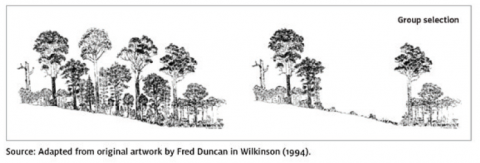Australia’s forests and forestry glossary
Genetic diversity
The diversity of genetic information within and between individual species.
Genetic resources
Genetic material of plant, animal, microbial or other origin that has actual or potential value.
Genotype
The genetic constitution or make-up of an organism.
See Phenotype.
Genus
Geographic information system (GIS)
A system for capturing, storing, analysing and managing data and associated attributes that are spatially referenced to the surface of the Earth.
Geospatial
Relating to the relative position of features on the surface of the Earth.
Girder
A specialised, large-dimensioned, durable timber product, usually in squared-end form, that is used in building bridges, wharves and the framework of large buildings.
Global carbon cycle
The movement of carbon between different parts of the Earth’s crust, ocean, biosphere and atmosphere, including the storage of carbon in those parts.
Grafting
A method of plant propagation, whereby a bud, shoot or tissue of one plant is joined with another plant.
Green Triangle
1. A region straddling the state border between south-west Victoria and south-east South Australia where there are significant areas of commercial plantations, as well as wood-processing facilities.
2. The National Plantation Inventory region of this name.
Green wood
1. Wood freshly harvested or milled that has not been dried.
2. In regards to sandalwood, wood from live sandalwood trees that meets a specified quality standard and size.
See Harvesting, Sandalwood.
Greenhouse effect
Warming of the Earth due to the absorption of infrared radiation by atmospheric greenhouse gases, including carbon dioxide.
See Greenhouse gas.
Greenhouse gas
Gas that affects the temperature of the Earth’s surface and climate by absorbing infrared radiation. Greenhouse gases include water vapour, ozone, chlorofluorocarbons, carbon dioxide, methane and nitrous oxide. National greenhouse gas inventories report anthropogenic emissions and removals of greenhouse gases not controlled by the Montreal Protocol on Substances that Deplete the Ozone Layer.
See Carbon dioxide equivalent, Greenhouse effect, National Greenhouse Gas Inventory.
Gross calorific value
The amount of heat released by a fuel during combustion under standard conditions.
Gross domestic product
The total market value of goods and services produced in a country in a given period, after deducting the cost of intermediate goods and services used in production (but not deducting allowances for the consumption of fixed capital, or depreciation). The sum of the value added by each industry across the economy.
See Industry value added.
Gross value of production
Value placed on production at the wholesale prices realised in the marketplace (where the marketplace refers to local consumption, export, or a point before value-adding by a secondary industry). Gross value of production provides a value for products that do not have a final market price.
See Value-adding.
Group selection
A native forest silvicultural system in which groups (small patches or stands) of trees are harvested, allowing for subsequent regeneration and leading to a forest comprising patches of differently aged trees.
See Harvesting, Regeneration, Selection harvesting, Silvicultural system, Uneven-aged forest.

Click here for an enlarged version.
Growth stage
A stage in the development of trees or forests, associated with tree or stand age. Four growth stages for trees or forests are recognised in Australia: Regeneration, Regrowth, Mature and Senescent.
See Mature, Regeneration, Regrowth, Senescent.

Click here for an enlarged version.
Gymnosperm
A plant, such as a cycad or conifer, the seeds of which are not enclosed within an ovary.
See Conifer.
